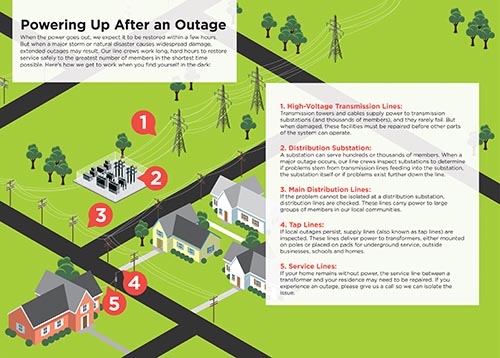Power Restoration
A major storm has just hit our electric system, causing widespread outages and significant infrastructure damage. Your power is out and your first question is when it will be restored. Below, we will walk you through the steps that BARC takes to restore power. Our restoration process is based on industry best practices and standards and is annually reviewed for performance improvement.

We have come to expect that if we lose electric service it will be restored within a few hours at most. But when a devastating event like a tornado, derecho, ice storm, or snowstorm causes major damage, longer outages cannot be helped. Crews work long, hard hours to methodically and safely restore service. Every electric cooperative follows a single basic principle when it comes to restoring power. The priority goes to the lines that will get the most people back in service the quickest. This begins with the main 3-phase lines originating at the substation. It then continues out to the tap lines, and then to the individual service lines. Again, the basic principle continues to apply: the shorter your tap or service line or the more people on it, the more likely your service will get restored first.
Step 1
All repairs start with the main “backbone” lines. Crews are dispatched to various 3-phase circuits, and starting at the substation, crews progress outward, repairing and noting damage. If crews do not have the appropriate equipment or materials to perform a repair, they may note the damage and move on. This is most common where a pole is broken, and the crew is not equipped with the equipment or pole to perform the replacement, but it may happen in other situations as well.
Restoring power also entails repeat trips from the site of the damage/repair to the power source, which can be miles away. Restoration usually occurs in segments, with crews creating visible openings between two points on the system. This is why you may sometimes see BARC vehicles travel back and forth in front of your home during an outage restoration. Sometimes, after repairs are made, the power does not hold and goes back out. This requires additional redundant trips to assess the cause, make the additional repair, and return to the power source to close the line back in service.
Step 2
Isolating damage and restoring tap lines. With the main lines restored, crews now can isolate damage on single-phase tap lines and perform repairs. Though some repairs may be closer to the substation, or to the mainline, BARC’s priority is fixing lines that serve the most number of customers, and/or require the least amount of time. Again, the priority is maximizing time to restore the most number of customers.
Step 3
Tap and Service Lines. It is, unfortunately, a fact of life that the smaller tap lines serving small numbers of homes and long tap lines serving single services get restored last. These homes have seen the crews driving by their home and working right across the road. They see lights in the homes of all their neighbors but they still don’t have power. Individual repairs that serve the fewest homes and/or require the most time come after all distribution and tap lines are restored.
Industry best practice states that crews should not spend hours fixing one outage when they can move down the road and restore power to dozens of homes in the same amount of time.
